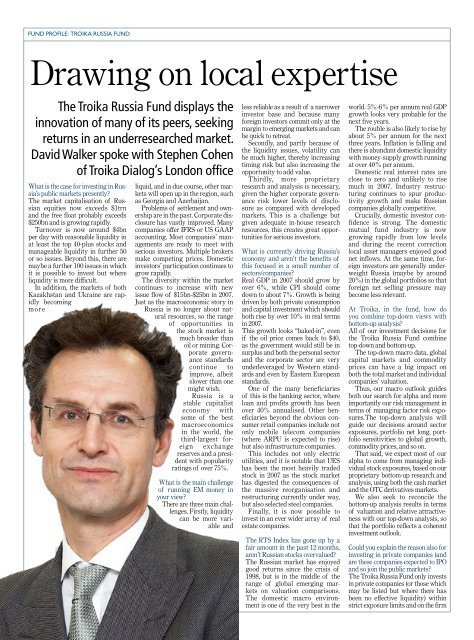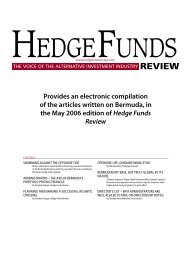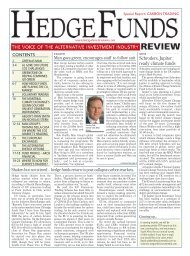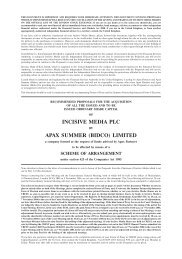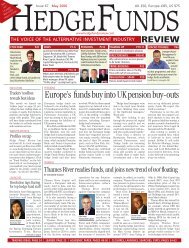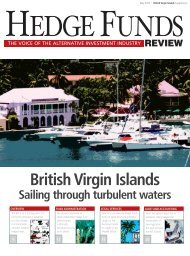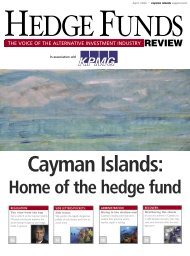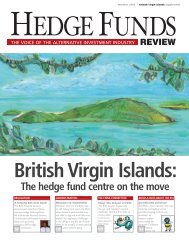fund pr<strong>of</strong>ile: troika russia fundDrawing on local expertiseThe Troika Russia Fund displays theinnovation <strong>of</strong> many <strong>of</strong> its peers, seekingreturns in an underresearched market.David Walker spoke with Stephen Cohen<strong>of</strong> Troika Dialog’s London <strong>of</strong>ficeWhat is the case for investing in Russia’spublic markets presently?The market capitalisation <strong>of</strong> Russianequities now exceeds $1trnand the free float probably exceeds$250bn and is growing rapidly.Turnover is now around $4bnper day with reasonable liquidity inat least the top 40-plus stocks andmanageable liquidity in further 50or so issues. Beyond this, there aremaybe a further 100 issues in whichit is possible to invest but whereliquidity is more difficult.In addition, the markets <strong>of</strong> bothKazakhstan and Ukraine are rapidlybecomingm o reliquid, and in due course, other marketswill open up in the region, suchas Georgia and Azerbaijan.Problems <strong>of</strong> settlement and ownershipare in the past. Corporate disclosurehas vastly improved. Manycompanies <strong>of</strong>fer IFRS or US GAAPaccounting. Most companies’ managementsare ready to meet withserious investors. Multiple brokersmake competing prices. Domesticinvestors’ participation continues togrow rapidly.The diversity within the marketcontinues to increase with <strong>new</strong>issue flow <strong>of</strong> $15bn-$25bn in 2007.Just as the macroeconomic story inRussia is no longer about naturalresources, so the range<strong>of</strong> opportunities inthe stock market ismuch broader thanoil or mining. Corporategovernancestandardscontinue toimprove, albeitslower than onemight wish.Russia is astable capitalisteconomy withsome <strong>of</strong> the bestmacroeconomicsin the world, thethird-largest foreignexchangereserves and a presidentwith popularityratings <strong>of</strong> over 75%.What is the main challenge<strong>of</strong> running EM money inyour view?There are three main challenges.Firstly, liquiditycan be more variableandless reliable as a result <strong>of</strong> a narrowerinvestor base and because manyforeign investors commit only at themargin to emerging markets and canbe quick to retreat.Secondly, and partly because <strong>of</strong>the liquidity issues, volatility canbe much higher, thereby increasingtiming risk but also increasing theopportunity to add value.Thirdly, more proprietaryresearch and analysis is necessary,given the higher corporate governancerisk lower levels <strong>of</strong> disclosureas compared with developedmarkets. This is a challenge butgiven adequate in-house researchresources, this creates great opportunitiesfor serious investors.What is currently driving Russia’seconomy and aren’t the benefits <strong>of</strong>this focused in a small number <strong>of</strong>sectors/companies?Real GDP in 2007 should grow byover 6%, while CPI should comedown to about 7%. Growth is beingdriven by both private consumptionand capital investment which shouldboth rise by over 10% in real termsin 2007.This growth looks “baked-in”, evenif the oil price comes back to $40,as the government would still be insurplus and both the personal sectorand the corporate sector are veryunderleveraged by Western standardsand even by Eastern Europeanstandards.One <strong>of</strong> the many beneficiaries<strong>of</strong> this is the banking sector, whereloan and pr<strong>of</strong>its growth has beenover 40% annualised. Other beneficiariesbeyond the obvious consumerretail companies include notonly mobile telecom companies(where ARPU is expected to rise)but also infrastructure companies.This includes not only electricutilities, and it is notable that UEShas been the most heavily tradedstock in 2007 as the stock markethas digested the consequences <strong>of</strong>the massive reorganisation andrestructuring currently under way,but also selected steel companies.Finally, it is now possible toinvest in an ever wider array <strong>of</strong> realestate companies.The <strong>RTS</strong> Index has gone up by afair amount in the past 12 months,aren’t Russian stocks overvalued?The Russian market has enjoyedgood returns since the crisis <strong>of</strong>1998, but is in the middle <strong>of</strong> therange <strong>of</strong> global emerging marketson valuation comparisons.The domestic macro environmentis one <strong>of</strong> the very best in theworld. 5%-6% per annum real GDPgrowth looks very probable for thenext five years.The rouble is also likely to rise byabout 5% per annum for the nextthree years. Inflation is falling andthere is abundant domestic liquiditywith money-supply growth runningat over 40% per annum.Domestic real interest rates areclose to zero and unlikely to risemuch in 2007. Industry restructuringcontinues to spur productivitygrowth and make Russiancompanies globally competitive.Crucially, domestic investor confidenceis strong. The domesticmutual fund industry is nowgrowing rapidly from low levelsand during the recent correctionlocal asset managers enjoyed goodnet inflows. At the same time, foreigninvestors are generally underweightRussia (maybe by around20%) in the global portfolios so thatforeign net selling pressure maybecome less relevant.At Troika, in the fund, how doyou combine top-down views withbottom-up analysis?All <strong>of</strong> our investment decisions forthe Troika Russia Fund combinetop-down and bottom-up.The top-down macro data, globalcapital markets and commodityprices can have a big impact onboth the total market and individualcompanies’ valuation.Thus, our macro outlook guidesboth our search for alpha and moreimportantly our risk management interms <strong>of</strong> managing factor risk exposures.Thetop-down analysis willguide our decisions around sectorexposures, portfolio net long, portfoliosensitivities to global growth,commodity prices, and so on.That said, we expect most <strong>of</strong> ouralpha to come from managing individualstock exposures, based on ourproprietary bottom-up research andanalysis, using both the cash marketand the OTC <strong>derivatives</strong> markets.We also seek to reconcile thebottom-up analysis results in terms<strong>of</strong> valuation and relative attractivenesswith our top-down analysis, sothat the portfolio reflects a coherentinvestment outlook.Could you explain the reason also forinvesting in private companies (andare these companies expected to IPOand so join the public markets?The Troika Russia Fund only investsin private companies (or those whichmay be listed but where there hasbeen no effective liquidity) withinstrict exposure limits and on the firm
Drawing on local expertiseexpectation <strong>of</strong> an IPO in the nearfuture, typically three to six months.Companies raising capital likethis <strong>of</strong>ten need funds to restructurein order to make themselvesmore presentable for the IPO. Thediscount to the eventual IPO pricecan be very attractive. The issuinginvestment bank will <strong>of</strong>ten make alimited market in the pre-IPO stock.Thus, the positions can be pricedeffectively and we are able to <strong>of</strong>fermonthly liquidity in the fund withoutany material portfolio impact. Itwould be unlikely for these positionsto exceed 5%-7% <strong>of</strong> the portfoliototal. In fact, in recent months,there have been very few attractivesuch investments. Any exposure inthe Troika Russia Fund to pre-IPOsecurities would be counted insidethe self-imposed limit <strong>of</strong> a maximum<strong>of</strong> 20% <strong>of</strong> the total portfolioto less liquid securities.Could you comment on the degreeand focus <strong>of</strong> analyst coverage <strong>of</strong> theRussian market?Many major brokers now providegood cover the top 10 stocks, butbeneath that, coverage becomesthinner and is <strong>of</strong>ten confined to Russianspecialists. The strength <strong>of</strong> themarket and the scope for <strong>new</strong> issueshas spurred investment banksto increase their Russia coveragein recent years. As with all suchresearch, quality is variable and nosubstitute for in-house research.You note in your written materialthat you must be ready for “rapidchanges in corporate governance.”What do you mean here?Most <strong>of</strong> these rapid changes are forthe better, for example, more transparency,stock buybacks, increaseddividends, independent directors,better treatment for minorities, andso on, but, occasionally, some arefor the worse.Norilsk Nickel is a company wherechanges over the last 18 months haveall generally been positive, whichhas helped the share price. However,there is a possibility that the Governmentwill decide that the company’smain mining asset, the Taimyrore body, having been designated“strategic”, should now becomemore than 50% owned by the State,possibly by means <strong>of</strong> requiring amerger with an existing State-ownedmining company.How do you and the fund handlethe risk <strong>of</strong> liquidity draining fromstocks? You note the portfolio willhold between 40 and 70 stocks. Whatkind <strong>of</strong> liquidity can you get in themarket this far down (e.g. at the 70thstock level)?We are constantly focused onliquidity at a portfolio and an individualstock level. We are mindfulthat the positive trends <strong>of</strong> the lasttwo years might reverse. We monitorthe liquidity <strong>of</strong> the portfolio versusthe liquidity terms <strong>of</strong> the fund. Welimit the fund to a maximum <strong>of</strong>20% in less-liquid names and aimto be able trade out <strong>of</strong> most <strong>of</strong> these25-30 names within 30 days.Do you find stocks to borrow inRussia for the short side or do youonly use ADRs and GDRs?Every year it is becoming easier andcheaper to borrow Russian stocks.The range <strong>of</strong> stocks is increasing. Itis more difficult to borrow domesticshares but it is now possible. Wecan also take short positions via therapidly burgeoning, increasinglyliquid but still inefficient <strong>derivatives</strong>markets.What is the experience <strong>of</strong> themanagers at Troika in long/shortinvesting?Troika has managing equity long/short portfolios since July 2002and achieved net returns <strong>of</strong> 34.5%per annum through March 2006ahead <strong>of</strong> the launch <strong>of</strong> the TroikaRussia Fund.The Troika Russia Fund is managedjointly by Oleg Larichev andVladimir Potapov. Oleg Larichev,the chief investment <strong>of</strong>ficer <strong>of</strong>Troika Dialog Asset Managementhas been managing these portfoliosfrom inception, for almost five yearsnow. He has been with the companysince 1998 and the Troika groupsince 1996. Vladimir and Oleg haveworked together for four years now.In terms <strong>of</strong> shorts, do you use theseto protect on the downside or tomake money? And have there beenperiods when the <strong>RTS</strong> index fell butyou rose?We use shorts primarily in pairtrades to make money and aim toprotect the downside by managingour delta-adjusted net exposure,using both OTC <strong>derivatives</strong> and thecash market. When we were managingseparate accounts, there wasa 12-month period ending 31 March2005 when the market was down -10.6% and we were up 12.6%. Morerecently, in January 2007, when themarket fell by 4.1%, we were onlydown -0.3%.What risk controls do you have inplace in terms <strong>of</strong> stop-losses andsector/stock limits?Given the huge individual stock volatilityin Russia, we do not have automaticstop-loss controls but rathercompulsory reviews <strong>of</strong> positions bythe full team and by the OversightCommittee when they fall betweencertain amounts.How large is your universe <strong>of</strong> potentialinvestee companies?The universe is growing andchanging constantly, but in theRussia+CIS region, we look at about125 companies and up to a further 50with limited liquidity.What research factors do you considerbefore making long/short pairtrade recommendations?Our research team maintains modelson all the companies in which weinvest and continuously monitorvaluation comparisons intra sector.We use a variety <strong>of</strong> valuation techniquesbut primarily discountedcashflow. We are also very carefulto consider possible short/mediumterm event risk at individual companiesbefore initiating any long/short position.In January you had 29.9% in oiland gas and 14.9% in metals, each<strong>of</strong> which one would assume wouldhave factor exposure to the crude oilprice – do you limit factor exposurein the fund?We actually had very limited exposureto oil per se and have donesince July 2006, preferring gas. Theliberalisation <strong>of</strong> the domestic gasmarket through 2011 will still leaveRussian gas prices at less than 50%<strong>of</strong> Western European levels but representa 250% increase on currentlevels. The resultant incrementalpr<strong>of</strong>it flow will not be that sensitiveto the underlying oil price. Ourmetal exposure was concentratedon Norilsk Nickel, where the stockwas cheap on global comparisonsand we expected continued upwardrevisions for the medium/long-termnickel-price market forecasts.Thus, while, there was someshort-term oil factor risk in thesestocks, which we did manage, theinvestment logic was not related tooil-price expectations.You note “investors have a visceralreaction to sell Russia when oil isweak.” Is this a logical reaction on thepart <strong>of</strong> investors? And do you protectby shorting, or going to cash?The size <strong>of</strong> both Russia’s currentaccount and fiscal surpluses isrelated to the oil price, which thusimpacts money-supply growth rates.In the short term, this can affectoverall market-valuation levels. Fornow, the investment opportunity isrelated to domestic demand which ispretty independent <strong>of</strong> the oil price.So far, we have effectively limiteddownside and managed volatilitythrough OTC <strong>derivatives</strong>. Ifwe became medium/longer-termbearish, we would also reduce thenet long by increasing shorts.You had around 20% in cash in January,this seems quite high, and only6% net in shorts, this seems quitelow, are these positions intentional?These figures were just month-endsnapshots. The stock short has moretypically been around 15% +/-5%.But we also use OTC <strong>derivatives</strong>to create synthetic shorts and lookto manage our delta-adjusted net.These are <strong>of</strong>ten OTC single-stockoptions, so the cash position doesnot reflect the true exposures. Deltaadjustedgross has been up as highas about 130%. Overall, we need tomanage the aggregate risks we aretaking. The OTC options have beenvery pr<strong>of</strong>itable, as is evident fromthe excellent returns, but we havebeen wary about piling too muchextra risk on top <strong>of</strong> this.Your monthly fact sheet on 31 Januaryreads “Sberbank’s <strong>new</strong> issuehad been much trailed but the pricinghad been unclear. A series <strong>of</strong> contradictoryand apparently uncontrolledannouncements by several <strong>of</strong> the partiesinvolved in the issue and the consequentvolatility in the share pricesuggests attempts at price manipulationmay have been afoot.” How doyou guard against getting involved insuch deals, and is this kind <strong>of</strong> thingprevalent in Russian markets?In any market at any one time, manycommentators are seeking to influenceprices by trying to get their side<strong>of</strong> the story heard. In Russia, thereare fewer controls around this.It is thus essential to understandthe motivations <strong>of</strong> those involvedand to be able to interpret their messagesclearly. This can create opportunitiesas well as pitfalls.What is the main opportunity forRussia in the coming year?The main investment opportunity in2007 is the gradual growing recognition<strong>of</strong> the Russian domestic demandstory. There are many ways to getexposure to this. For now, we remainfocused on utilities and financialswith some selected metal stocks. Wethink the story will persist and willcontinue to look for the best valueexposure to this story, which maychange over the course <strong>of</strong> the year


